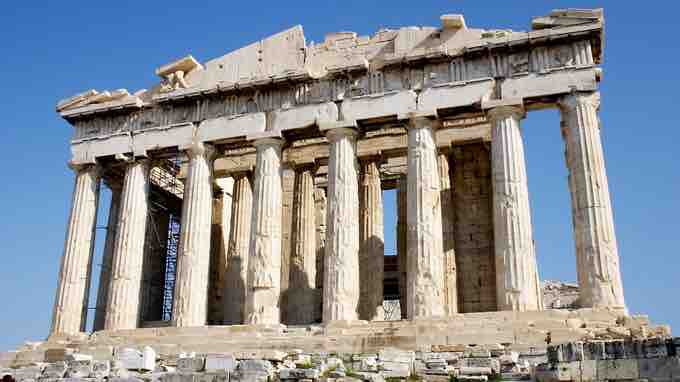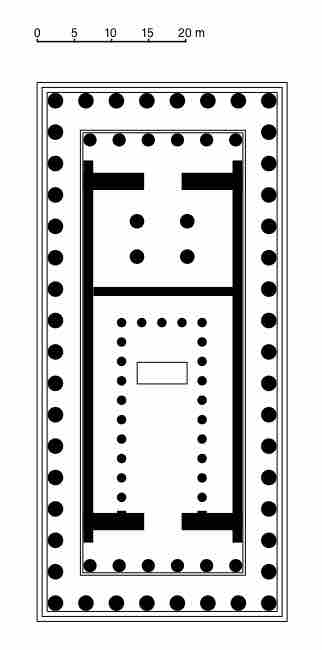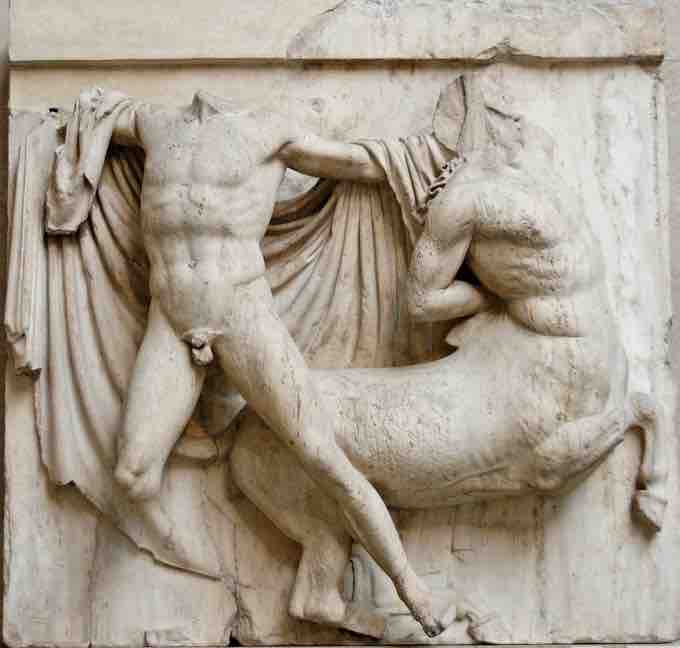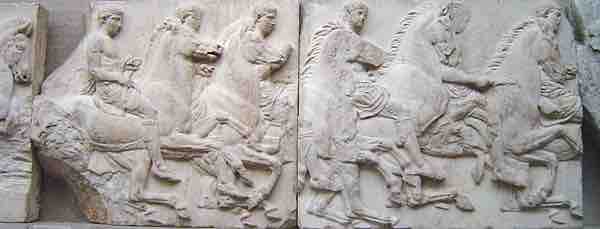Today the Parthenon is considered the crowning element on the Acropolis . It was built under Pericles during the Golden Age of Athens as a temple dedicated to Athena Parthenos. It later was converted into a Christian church and then a mosque, when Greece was conquered by the Ottomans in the fifteenth century. It later became an arsenal, which unfortunately was ignited and destroyed parts of the temple. In the early 1800's Lord Elgin persuaded the Ottoman Turks to part with the remaining pediment sculptures, which he removed and took to London and the sculptures now reside in at the British Museum. The Greeks have requested the return of sculptures, but with no success.

Parthenon
The Parthenon as it stands today. Acropolis, Athens, Greece. ca. 447-438 BCE.
Architecture
The Parthenon replaced the original temple, the Hekatompedon that was first erected for Athena. In building the new temple, the Greeks moved the temple's footprint to south of the Hekatompedon. This not only allowed access to the original site but it also placed the Parthenon in a much more prominent position overlooking Athens.
While the artist Phidias was in charge of the overall plan of the Acropolis, the architects Iktinos and Kallikrates designed and oversaw the construction of the Parthenon. The Parthenon is built completely from Pentalic marble, although parts of its foundations are limestone from a pre-480 BCE temple that was never completed. The design of the Parthenon varies slightly from the basic temple ground plan . The temple is peripteral, and so is surrounded by a row of columns. In front of both the pronaos and opisthodomos is a single row of prostyle columns. The opisthodomos is large, accounting for the size of the treasury of the Delian League, which Pericles moved from Delos to the Parthenon. The pronaos or porch is so small it is almost non-existent. Inside the naos is a two-story row of columns around the interior and set in front of the columns is the cult statue of Athena.

Parthenon
Plan of the Parthenon.
The Parthenon's elevation has been streamlined and shows a mix of Doric and Ionic elements. The exterior Doric columns are more slender and their capitals have become rigid and cone like. The entablature has also shrunk and appears less weighty then earlier Doric temples. The exterior of the temple has a Doric frieze consisting of metopes and triglyphs. Inside the temple are Ionic columns and an Ionic frieze wraps around the exterior of the interior building. Finally, instead of the columns the whole building an entasis, a slight curve to compensate for the human eye. If the building was built perfectly at right angles and with straight eyes, the human eye would see the lines as curved. In order for the Parthenon to appear straight to the eye, Iktinos and Kallikrates added curvature to the building that the eye would interpret as straight.
Cult Statue of Athena Parthenos
The cult statue of the Parthenon was a huge chryselephantine statue of Athena Parthenos sculpted by Phidias . It was considered the greatest achievement of Phidias, who himself was already considered the greatest sculptor in Greece. While the statue does not survive, written accounts and reproductions (miniatures and representations on coins and gems) provide us with an idea of what the sculpture looked like. The statue was made out of ivory, silver, and gold and had a wooden core support. Athena stood crowned, wearing her helmet and aegis. Her shield stood upright at her left side and her left hand rested on it while in her right hand she held a statue of Nike.

Reconstruction of Athena Parthenos by Phidias
A reconstruction of Athena Parthenos by Phidias, from the replica of the Parthenon in Nashville, Tennessee, USA.
Metopes
The sculpted reliefs on the Parthenon's metopes are both decorative and symbolic and relate stories of the Greeks against the others. Each side depicts a different set of battles. Over the entrance on the east side is a Gigantomachy, depicting the battle between the giants and the Olympian gods. The west side depicts an Amazonomachy, showing a battle between the Athenians and the Amazons. The north side depicts scenes of the Greek sack of Troy at the end of the Trojan War and the south side depicts a centauromachy, or a battle with centaurs. The centauromachy depicts the mythical battle between the Greek Lapiths and the Centaurs which occurred during a Lapith wedding . These scenes are the most preserved of the metopes and demonstrate how Phidias mastered fitting episodic narrative into square spaces.

Centauromachy Metope
Metope from the south side of the Parthenon, of a Lapis and a Centuar. Acropolis, Athens, Greece. ca. 447-438 BCE.
Processional Frieze
The interior Ionic processional frieze wraps around the exterior walls of the naos. While the frieze may depict a mythical or historical procession, many scholars believe that it depicts a Panatheniac procession. The Panathenaic procession occurred yearly through the city, leading from the Dipylon Gate to the Acropolis and culminated in a ritual changing of the peplos worn by the ancient olive-wood statue of Athena. The processional scene begins in the southwest corner and wraps around the building in both directions before culminating in the middle of the of the west wall. It begins with images of horsemen preparing their mounts, followed by riders and chariots , Athenian youth with sacrificial animals, elders and maidens, then the gods before culminating at the central event. The central image depicts Athenian maidens with textiles, replacing the old peplos with a new one.

Horsemen in the processional scene
Horsemen in the processional scene on the Ionic frieze of the Parthenon. Acropolis, Athens, Greece. ca. 447-438 BCE.
Pediment
The east and west pediment were both described by ancient writers depict scenes from the life of Athena and the east pediment is in better preserved than the west. The west pediment depicted the contest between Athena and Poseidon for the patronage of Athens. At the center of the pediment stood Athena and Poseidon, pulling away from each creating chiastic and strongly charged, dynamic composition. The east pediment depicted the birth of Athena. While the central image of Zeus, Athena, and Haphaestus has been lost, the surrounding gods, in various states of reaction, have survived.